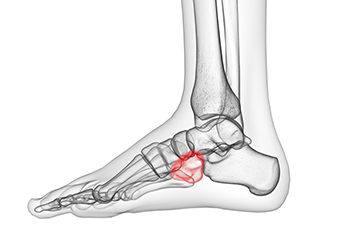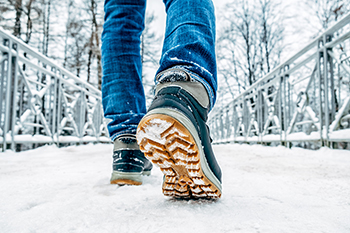Items filtered by date: August 2023
Let the Expert Treat Your Ingrown Toenails
Definition and Underlying Causes of Cuboid Syndrome

Cuboid syndrome, a lesser-known foot ailment, can gradually disrupt one's daily activities. This condition occurs when the cuboid bone, which is situated on the outer side of the foot, shifts out of its normal position. This misalignment can affect nearby joints and ligaments. While often mistaken for a sprain, cuboid syndrome can cause pain and discomfort, particularly during weight-bearing movements. Cuboid syndrome is typically triggered by activities involving sudden twists or impacts, such as sports or falls. People with flat feet or those engaging in repetitive motions are also susceptible. Poor footwear choices, inadequate arch support, and excessive pronation can contribute to developing cuboid syndrome. Recognizing the causes is the first step in managing this condition. If you have pain on the outside of your foot, it is suggested that you visit a chiropodist who can effectively diagnose and treat cuboid syndrome.
Cuboid syndrome, also known as cuboid subluxation, occurs when the joint and ligaments surrounding the cuboid bone in the foot become injured. If you think that you may have cuboid syndrome, please consult with Emily Yu, B.Sc from Uptown Foot Care Clinic. Our specialist will assess your condition and provide you with quality foot and ankle treatment.
Causes
The cuboid bone is one of the seven tarsal bones located in the foot. Cuboid syndrome develops when the cuboid bone moves down and out of alignment with the other bone (calcaneus bone) in the joint of the foot. Cuboid syndrome can be the result of a sudden injury like an ankle sprain, or it may develop slowly over time from repetitive tension through the bone and surrounding structures.
Symptoms
The most common symptom of cuboid syndrome is pain on the outside of the foot which may worsen with activity.
Other possible symptoms include:
Difficulty bearing weight on the affected foot
Swelling
Sensitivity on the bottom of the foot
Reduced range of motion
Diagnosis
A chiropodist can diagnose cuboid syndrome based on your medical history and a physical examination of the foot. Imaging studies, such as X-rays or MRIs, often fail to show the dislocated cuboid.
Treatment
Treatment often includes resting, icing, compressing and elevating the affected foot, taping, wearing orthotic inserts, and taking anti-inflammatory medications to reduce pain. The chiropodist may also be able to manipulate the dislocated bone back into alignment.
If you have any questions, please feel free to contact our office located in . We offer the newest diagnostic and treatment technologies for all your foot care needs.
Causes and Telltale Signs of Blisters on the Feet

Blisters can make even the simplest activities a painful ordeal, especially when they form on the feet. These fluid-filled pockets develop due to friction, heat, or continuous rubbing against the skin. Wearing shoes that do not fit correctly or performing strenuous physical activities can trigger blisters by subjecting the skin to excessive pressure. Moisture accumulation, such as sweaty socks or damp environments, can exacerbate the issue. Identifying blisters is relatively easy, as they appear as raised, fluid-filled sacs on the skin's surface. The skin surrounding the blister may become red and tender. As these pockets form a protective layer, it is beneficial to avoid popping them, which can reduce the risk of infection. Prioritizing proper footwear and practicing blister-prevention techniques can save your feet from this unwelcome discomfort. If you would like more information about how to prevent blisters from developing on the feet, it is suggested that you consult with a chiropodist.
Blisters can usually be treated at home, however, if you have recurring blisters or experience significant discomfort or pain, please consult with Emily Yu, B.Sc from Uptown Foot Care Clinic. Our specialist will assess your condition and provide you with quality foot and ankle treatment.
What Is a Blister?
A blister is a small pocket of fluid in the upper skin layers and is one of the body’s natural responses to injury or pressure. Blisters can also result from burns, fungal or viral skin infections, and the feet are particularly prone due to ill-fitting footwear and friction. Friction on the skin causes the upper layer of skin to separate from the lower layers. The space that this separation creates then becomes filled with a liquid called serum, which protects the lower layers of skin.
Treatment
If you notice a blister on your foot, you can cover it with a soft bandage or dressing to protect it. Popping the blister is discouraged. Doing so exposes the raw skin underneath it to bacteria and also raises the risk of infection. If a blister pops naturally, let it drain before covering it with a bandage. Blisters usually heal on their own or with home treatment, however, if your blister is recurring, very painful, or appears infected, it is recommended that you see a chiropodist for treatment.
Prevention
You can help to prevent blisters by wearing comfortable, well-fitted shoes. Keep your feet dry by wearing moisture-wicking socks and dust your feet with talcum powder if they tend to get sweaty. If you have areas on your feet that are more susceptible to blisters, you might be able to prevent the blister from forming by covering it with a pad.
If you have any questions, please feel free to contact our office located in . We offer the newest diagnostic and treatment technologies for all your foot care needs.
Risk Factors for Runners and Joggers

Running and jogging are popular forms of exercise, but they come with the risk of injuries. Roughly one-third of recreational runners will experience some type of running-related injury, many of which affect the feet, toes, and ankles. Common injuries include blisters, soft tissue injuries, and skin injuries from falls. Ankle sprains and plantar fasciitis are other common injuries. Several factors can increase the risk of injury, such as overtraining, poor technique, improper footwear, running on hard surfaces, and exposure to environmental hazards. Warming up before running with slow, dynamic, and sustained stretches can prepare your muscles and lower the risk of injury. Cooling down with stretches after your run can do the same. Experts recommend that runners stay hydrated, avoid pushing themselves beyond their fitness level, and increase running times and intensity gradually. Properly fitted running shoes and running on soft and even surfaces whenever possible helps to reduce risk. Additionally, taking enough recovery time and getting adequate sleep are vital for injury prevention. If you are experiencing foot, toe, or ankle problems related to running or jogging, it is suggested that you consult a chiropodist.
Although running is a wonderful exercise to keep you in shape, it can wreak havoc on your feet and ankles if you don’t take preventive measures. If you have sustained a foot and ankle injury from running, please consult with Emily Yu, B.Sc from Uptown Foot Care Clinic. Our specialist can help you maintain the health of your lower limbs and your mobility.
Some common running injuries include:
Achilles tendonitis
Shin splints
Ankle sprains
Stress fractures
Plantar fasciitis
Bursitis
What causes injuries?
These injuries are usually caused by overtraining, wearing the wrong shoes, running on hard surfaces, having tight and inflexible muscles, or having biomechanical issues in the feet or ankles.
What can I do to prevent injuries?
Train slowly and gradually
Give yourself plenty of time to recover following a run
Wear shoes that fit properly and support your foot
Avoid running on hard surfaces, like concrete
Stretch and strengthen the muscles of your lower legs
Warm-up prior to a run
Have your gait analyzed and your feet examined by a chiropodist to determine if there are any biomechanical problems that need to be treated
If you have any questions, please feel free to contact our office located in . We offer the newest diagnostic and treatment technologies for all your foot care needs.
Tips to Keep Your Feet Warm and Cozy During the Winter Months

When the chilly winter months approach, it is essential to take extra care of your feet to keep them warm and comfortable. Cold temperatures can lead to poor circulation, making the feet more susceptible to frostbite and discomfort. To keep our feet warm during winter, start by wearing warm and insulated footwear, such as lined boots or shoes made of materials such as leather. It is helpful to layer with moisture-wicking socks that can help keep the feet dry and cozy. Avoiding tight fitting footwear that may restrict blood flow and choose styles that provide enough room for wiggle room. When indoors, keep feet warm by wearing fuzzy socks or using heated foot warmers. Regularly moisturizing feet can also help to prevent dryness and cracking. By following these simple tips, you can enjoy the winter season with snug and toasty feet. If you are interested in having more information about how to keep your feet warm during the cold months, it is suggested that you speak with a chiropodist.
The winter months can bring about new or worsening foot and ankle problems. If you’re suffering from foot or ankle pain, please consult with Emily Yu, B.Sc from Uptown Foot Care Clinic. Our specialist can help you maintain the health of your lower limbs and your mobility.
Winter Foot Problems
Cracked heels - Dry, cracked skin on the heels of the feet that is associated with cold, dry weather
Athlete’s foot - A fungal infection on the skin of the feet
Blisters - Fluid-filled bubbles of skin that usually form in response to friction
Fractures - Broken bones in the feet or ankles
Metatarsalgia - General foot pain
Chilblains - Spasming of the small blood vessels in the toes in response to exposure to cold weather
Raynaud’s disease - Numbness, pain, and color changes in the toes due to cold weather
Prevention
Wear warm socks and shoes
Avoid prolonged exposure to the cold
Moisturize the heels regularly
Keep your feet clean and dry
Walk carefully in areas that may be icy
Wear non-slip shoes
If you have any questions, please feel free to contact our office located in . We offer the newest diagnostic and treatment technologies for all your foot care needs.
Symptoms of Sever’s Disease

Sever’s disease is a painful condition that affects children and young teenagers who frequently participate in running activities, such as football, soccer, and basketball. Sever’s disease happens as a result of an active growth plate in the heel where cartilage converts to the bone, and physical activity may cause this plate to become irritated. Heel pain is often the common symptom of Sever’s disease, and parents may notice their child begins to limp or favor one leg. This is considered to be a condition the child will gradually outgrow. In the meantime, mild relief may be found when the offending activity is temporarily stopped and the affected foot is rested and elevated. Some children will wear orthotics, which may be custom made that can provide relief while walking. If your child has symptoms of Sever’s disease, it is suggested that you confer with a chiropodist who can help you to manage this condition.
Sever’s disease typically affects young children and teenagers. If your child complains of foot pain, please consult with Emily Yu, B.Sc from Uptown Foot Care Clinic. Our specialist will assess your condition and provide you with quality foot and ankle treatment.
What Is Sever’s Disease?
Sever’s disease, also known as calcaneal apophysitis, is an inflammation of the growth plate in the heel bone. It is typically caused by overuse due to repetitive activities such as running, jumping, and playing certain sports. This condition most frequently affects children between the ages of 8 and 14.
Symptoms
Symptoms of Sever’s disease include:
Pain in the back or bottom of the heel
Pain when the sides of the heel are squeezed
Limping or walking on tiptoes to avoid putting pressure on the heel
Difficulty running, jumping, or participating in usual activities
Fatigue
Diagnosis
Sever’s disease is diagnosed by taking a thorough medical history and performing a physical examination. Imaging studies, such as an X-ray, can help rule out other injuries like a fracture.
Treatment
Sever’s disease typically heals without any long-term complications. Treatment involves resting the affected foot by reducing typical activities, wearing orthotics to support the foot, immobilizing the affected foot, taking medications to reduce pain and inflammation, and stretching the foot.
If you have any questions, please feel free to contact our office located in . We offer the newest diagnostic and treatment technologies for all your foot care needs.

